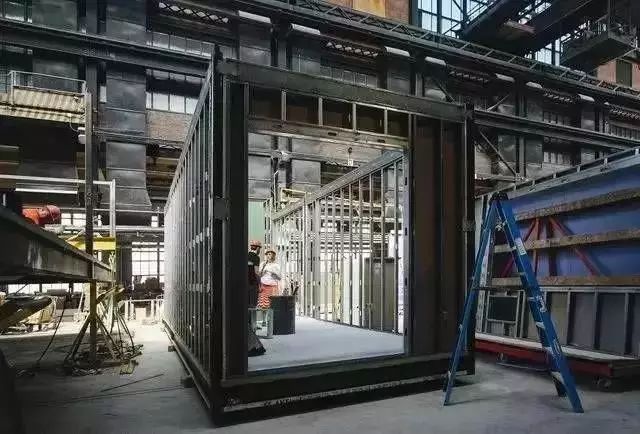This article explains in detail the brief history of the development of precast architecture and understands its past and present life
It is a complete precast construction system project.

At this time, a new construction method with fast construction speed and less labor occupation was urgently needed to meet the housing demand of various countries in a short time.
Early precast buildings in a broad sense include many contemporary and ancient architectural technologies.

The first large-scale precast public building, the Crystal Palace in London, was completed in less than six months.
His book “towards new architecture” laid the foundation of the most cutting-edge architectural theories such as industrialized housing and residential machinery.
For example, in ancient times (Hemudu Culture), China created the “tenon and mortise structure” of “beam column” architecture and began to implement “precast architecture”, which has been handed down to this day.


Mortise and tenon structure for fixing vertical components wooden mortise and tenon excavated from Hemudu Neolithic cultural site in Yuyao, Zhejiang Province is the earliest precast building component discovered by Archaeology in the world so far.
The first industrial revolution was basically completed around 1850, and Britain became the first industrial country in the world.
Although it is carried by horse, it pioneered the technical mode of factory precast components and on-site assembly, which is the first work of modern architecture (steel skeleton and glass curtain wall).
At the same time, urban development has brought a large number of farmers to the city and a large number of people into the city, A large number of houses, office buildings and factories need to be built in a short time, which has laid a foundation for the creation of construction industrialization.

All columns were made of stone and pre manufactured.

It includes many forms of sub assembly.

The buildings in continental Europe were generally affected by the war, suffered heavy losses, could not provide normal living conditions, and there was a shortage of labor resources.


Bricks and blocks used in most parts of the world are perhaps the simplest precast components.


Therefore, precast concrete buildings sprouted here and quickly entered the residential field of European countries.
1: Building industrialization 1.0 era: industrialization and mechanization (from the beginning of the 20th century to the middle of the 20th century).


The stone column is made of drum shaped blocks, which are connected by mortise and tenon or metal pins, and the wall is also made of stone blocks.
Le Corbusier, a master of modern architecture in France, began to conceive that houses could be manufactured in batches like car chassis.
It can be carried out on site or away from the site, and often involves standardization”.
From the ancient times of “camp cave in winter and nest in summer” to today, all buildings created by human beings are basically “precast buildings”.
The Crystal Palace has experienced the whole process from design conception, production, transportation to final construction and demolition.
During the industrial revolution, a large number of farmers flocked to cities, and the housing demand caused by war and disasters.

In the early stage, the main buildings used stone.

It is 408 feet wide and 1851 feet long.
The general development trend is closer to the development process of human civilization and will lead the development and reform of the global construction industry.
Limited to material properties, the span of stone beam is generally 4 ~ 5m, but the maximum is 7 ~ 8m.


The structure of ancient Greek architecture belongs to the beam column system.

The earliest prototype of Maison domino 02 in Le Corbusier Maison citrohan series.

He hoped that the construction industry would “copy” buildings like “batch copy” cars in the first half of the 20th century.
In order to promote international exchanges and cooperation in construction products, construction standardization has also been greatly developed..
London Crystal Palace 04, which is being built with precast parts, the development process of global construction industrialization is closely related to the process of industrial revolution.
Ancient Greece belongs to beam column structure system architecture 03.
The construction industry research and Information Association (CIRIA, 1997) defines pre assembly as follows: “pre assembly: organize and complete most of the final assembly work for a product before it is finally in place.
01 definition of precast architecture in 1921, the concept of “building a house like a car” was first mentioned by French architect Corbusier in moving towards new architecture.
Around 600 BC, wood columns underwent a material change called petrification.


According to the internal causes and performance of the development of global construction industrialization, it can be roughly divided into the following four development stages.
Relying on the economy, accuracy and rapidity provided by modern industrial technology, Joseph Paxton completely adopted the continuous production mode of unit parts for the first time, built a large space by means of assembly structure, and designed and built the Crystal Palace, the venue of the London World Expo.
With the rise of the second industrial revolution and the end of the first World War, the economic recovery of European countries and the progress of technology have brought the development of modern building materials and technology.
The American Construction Industry Association (CII, 1986) defines pre manufacturing and pre assembly in a basic report as follows: “pre manufacturing is a manufacturing method, which generally combines various materials on special equipment to form a final installation part”.
Similarly, ancient Greek buildings in the 8th-6th century BC were made of wood, mud brick or clay.
It has five spans, three floors high and a construction area of about 74000 square meters.

The British Empire was in its heyday, and the Queen invited countries all over the world to participate in the first World Expo held by the British Empire.
We often hear a variety of terms to describe the production units of precast buildings, such as “box”, “unit”, “module” or “set, or parts for assembly”.


